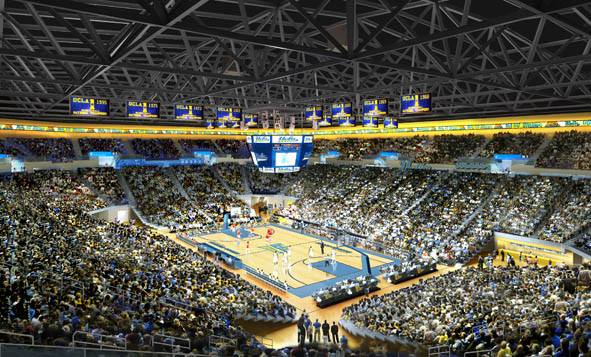With a wall-size “First to 100″ logo plastered just inside the J.D. Morgan Center and banners representing only national championships hanging crisply under the lights of Pauley Pavilion, UCLA Athletics’ pride in its unrivaled success reverberates through campus.
But perhaps because of all the controversy surrounding the exact plan and cost of the renovation, the one fact that seems to have gotten lost is the one fact everyone can agree on: Pauley needs a renovation if the school hopes to be “First to 200″ later this century.
“I think we had to do this,” Senior Associate Athletic Director Ross Bjork said. “From a critical timing standpoint, if we waited any longer then I think you would see us slip a little bit from the standpoint of being competitive and having the tradition that we have. We need to maintain that. We had to do this now.”
The benefits of the renovation to athletes are countless. They range from more space for loud students to a new weight room and even a team lounge.
But perhaps the most important impact the renovation will have on Athletics has nothing to do with a physical amenity. Coaches now have a renovated Pauley Pavilion at their disposal as a recruiting tool to bring the new generation of top athletes to Westwood.
“It gives you a huge recruiting tool to be able to sell prospective student-athlete’s on this state-of-the-art unbelievable facility, which we hope to and plan to hang more banners in,” women’s basketball coach Nikki Caldwell said.
Brendan Lane is a freshman on the men’s basketball team who got to hear one of the first recruiting pitches which included details about the Pauley Renovation. Lane and his class of 2013 teammates will have the first opportunity to play in the renovated arena if they remain here through their senior year.
Lane said that coaches made a point to mention the renovation but that it wasn’t a deciding factor for him.
“It (the renovation) will definitely be a big factor when it changes, but as of right now we probably don’t think about it much,” Lane said.
But in order to reap the benefits of what Bjork called “the crown jewel facility for UCLA campus,” teams, the marketing department and the administration will have to suffer a few headaches first.
After exterior construction ends, the area is scheduled to be shut down from spring 2011 to fall 2012 in time for basketball season. During the 2011-2012 school year then, teams will be forced to play in alternative venues and hope that their fans travel with them.
Bjork said men’s and women’s volleyball, along with gymnastics, may be able to find their temporary homes on campus in locations such as Collins Court. But men’s and women’s basketball, and even gymnastics when it has critical meets, will need to travel off campus to play their home games.
Bjork said UCLA has engaged in a dialogue with the Staples Center, Honda Center and the Great Western Forum about serving as a second home.
“The Forum is a little more open,” Bjork said. “Their dates are much more flexible. It’s a little easier to plug in our calendar with The Forum than it is with these other venues. The good thing is, is we have options. Nothing is definitive yet with any of those facilities.
“Maybe the (UCLA v.) USC game is at the Staples Center because that is a big marquee game. But yes, The Forum is more flexible on dates and more open so you could assume that a majority of the games will be played at The Forum.”
Several fans of UCLA already assume most games that season will be played at the Forum, and some have voiced concern over the location of the arena in Inglewood.
While acknowledging the concern, Bjork said the Lakers’ 30-plus years playing there was encouraging.
“I think the Lakers have a track record of security and operational issues that they dealt with,” he said. “There is plenty of parking around the Forum so I think that you make sure those areas are secure. I think we look at it where we try to embrace the community and partner with the community for that year.”
But while Inglewood residents may flock to the UCLA game, students may face other logistical challenges. Rather than taking the short stroll down to campus on a Thursday night, students will have to fight traffic and the unhappy prospect of school the next day if they wish to see games in person.
Bjork said “transporting students to off-site athletic events is part of equation,” and suggested that incentives such as pizza on the bus might be included.
Caldwell’s team is currently doing its best to simply create a fan base and she acknowledged that things would be “a little bit different” in 2011.
“It will definitely be a challenge for more students to come out and support (the team), but I still think it will be just as good,” Lane added.
Caldwell said Athletics will have to become even more creative with their marketing ideas and suggested ideas like a “Dads and Daughters Day” targeted at the Inglewood community.
Yet despite the logistical issues that plague that season, the second-year coach is able to half-jokingly see the best part about playing away from home.
Caldwell said, “It may be good for us because based on last year, we need to learn how to win on the road.”
